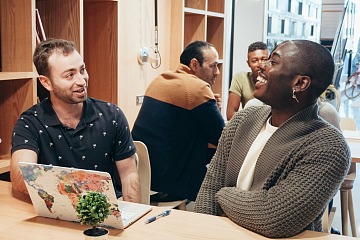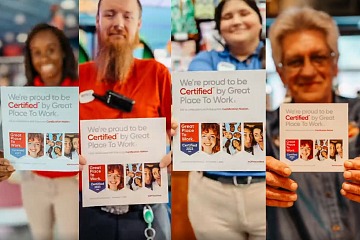Certification, Employee Engagement, Employee Experience, Employee Listening, Employee Surveys, Survey Design
Understand how employee surveys play a critical role in influencing the 'Moveable Middle' within your organization.
I began practicing Muay Thai recently to learn a new skill and get in shape. An unexpected benefit is my coach sharing advice that applies to my everyday life. This morning, he said, “Consistency boils down to two things: how you show up and how often you do it.”
Employee surveys are a key tool for measuring the consistency of your employee experience. Using the Great Place To Work® Trust Index™ Survey, you can identify which demographic groups (such as generations, race/ethnicity, managerial level, department etc.) are having a positive experience and those who need more support.
Be sure to note statements and populations with a high volume of inconsistent responses – those who answer neither positively nor non-positively. We call these folks your “moveable middle,” as they present an opportunity for rapid growth potential.
What is the "moveable middle?”
The Trust Index Survey scale differs from the typical Likert scale (strongly agree to strongly disagree) that employee net promoter score (eNPS) surveys use. The Trust Index Survey does not simply measure whether employees agree with a specific statement.
Bringing it back to my Muay Thai coach, the scale measures consistency – what folks experience and how often it is the case (almost always true to almost always untrue). How often is true that management keeps you informed? How often is it true that people are treated fairly? How often is it true that people feel like they can be themselves?
Your inconsistent responses are folks answering in the middle answer option: sometimes true or sometimes untrue. It’s not that these survey takers never have positive experiences, but that these positive experiences are inconsistent.
This inconsistency can spark many questions: when do these folks have positive experiences? When do they have non-positive ones? What factors are influencing them? What can we do to impact that change?
For example, you could see a high volume of “moveable middle” responses in statements about compensation. Is it your communications regarding compensation that are the problem? Is there a real opportunity to change the compensation structure?
Filtering these responses is a great way to identify areas with the most potential for meaningful increases. It’s useful to think about survey response data in terms of cause and effect: if employees’ responses are the effect, what are the potential causes?
3 reasons employers should pay close attention to the moveable middle
1. Opportunity to identify areas for improvement
The moveable middle is a population with huge potential for improvement with less of a lift than converting non-positive responses into positive responses.
Outside of identifying gaps to benchmark data, identifying statements and demographics with the largest moveable middle is a great first step in identifying opportunities in your survey results.
2. Potential for increased employee engagement and productivity
Our research shows that engaged employees have business impact. Imagine the productivity and innovation left on the table caused by an inconsistent experience. With a lower barrier to entry than fully disengaged employees, your moveable middle can move your bottom line.
3. Ability to convert ambivalent employees into advocates
People having inconsistent experiences could quickly change from indifferent employees to workplace promoters.
When such employees see leadership take the time to listen and seek feedback, then implement change based on that feedback, those employees are likely to become advocates – not only in how they see their experience, but also how they share their experience with new hires and their network.
“Your moveable middle and move your bottom line”
How to analyze the moveable middle's survey responses
1. Identify trends and patterns
First, recognize which survey statements have your highest volume of responses from your moveable middle and see what connections stand out.
For example, if you have a large moveable middle in psychological safety, do you also have one in work-life balance? How about in space for innovation and bottom-up communication?
Look for relationships between statements to begin painting your employee experience picture.
2. Pinpoint specific areas of concern
Have you made strategic investments in your company culture and not seen the expected impact? Revisit your action plan, create your hypotheses around why the needle hasn’t moved the desired distance, and listen further to determine the gap between where you are and your goal.
3. Compare responses with highly engaged and disengaged employees
It’s important to not forget about your positive and non-positive scores as well. Investigating what factors are influencing both sides of this coin can provide color and clarity to your inconsistent experiences. Chances are that the people in the moveable middle are experiencing and balancing a variety of positive and negative factors at once.
3 sure-fire strategies for engaging the moveable middle
Address key areas of concern
Choose which handful (no more than 5) of statements and/or demographics you will focus on. Address this with your executives, then leadership, then the broader business. Be sure to keep all stakeholders aware of where you are in the process and when they can expect to see the action plan come to fruition.
Encourage open communication and feedback
We can see lots of what in survey results, but two-way communication, feedback, and collaboration help us get to why and how.
Create opportunities for your people to share feedback in a confidential way with questions like:
- What do you see in your day-to-day that leadership doesn’t see?
- When was the last time you had a positive experience in this area? What did it look like?
- What do you need from leadership to have this experience more consistently?
- What things can you do to create this experience for yourself and others more consistently?
Recognize and reward improvements in engagement
Extend gratitude to your people when you start to see behaviors and patterns that foster more stable and positive experiences.
Connect these behaviors directly to your organizational values, demonstrating that they are more than just words on a website; they are the guideposts for actions and a shared code. Recognize and thank folks who actualize these values, thereby transforming abstract ideas into tangible, measurable practices.
How to enhance employee experience by tapping moveable middle responses
Incorporate feedback into organizational policies and processes
While every organization must make top-down decision, seeking employee voices early and often can have a significant impact on their experience.
As much as possible, shift the messaging from, “Here’s what is going to happen. Any questions?” to “Here’s what we’re thinking of doing. Before we move forward any further, we want to understand how this will affect you.”
This will build trust between leadership and the workforce, creating the environment for them to feel heard. Even if employees wish the final decision went a different way, they won’t feel left out.
Use insights to inform future survey design
By identifying areas with a moveable middle, you can add more pointed statements to future surveys to measure your plan’s effectiveness on a multi-point scale. That way, after you've identified the things that may be able to move the needle, you can measure whether (and how well) your solutions are working.
Track progress and adjust strategies as needed
Don’t be afraid to adjust the action plan as you go along. In any organization, agility is a key success behavior. Your humility and communication in moving the levers on your plan will show that the survey is a real avenue to be heard and that it has tangible impacts on their day-to-day at work, ultimately building trust.
Move forward by moving the middle
The moveable middle is a great place to start if you want to know what employee experiences are inconsistent. Instead of starting with zero momentum, you have a chance to understand not only what drives the inconsistency, but also what will create a more consistent experience for all.
Looking to understand your moveable middle and employee experience? Get started in surveying your employees here.













